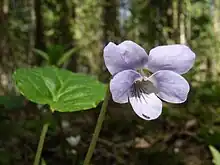Viola selkirkii
Viola selkirkii is a species of violet known by the common names Selkirk's violet and great-spur violet. It is native throughout the Northern Hemisphere, its distribution circumboreal.[1][2][3]
| Viola selkirkii | |
|---|---|
 | |
| Scientific classification | |
| Kingdom: | Plantae |
| Clade: | Tracheophytes |
| Clade: | Angiosperms |
| Clade: | Eudicots |
| Clade: | Rosids |
| Order: | Malpighiales |
| Family: | Violaceae |
| Genus: | Viola |
| Species: | V. selkirkii |
| Binomial name | |
| Viola selkirkii | |
This species is a rhizomatous perennial herb with hairy, heart-shaped leaves. The flowers are up to 1.5 centimeters wide and are violet in color. They lack the beards that some other violets have. Each flower has a spur up to 7 millimeters long. The fruit is a capsule up to 6 millimeters wide.[1][3] Flowering occurs between April and July. In some regions this violet may be confused with its relatives, the hookedspur violet (V. adunca) and the common blue violet (V. sororia). Its relatively large spur is a good distinguishing characteristic.[3]
Like some other violets, this species forcefully ejects its mature seeds from the fruit capsules. Ants then pick up the seeds and aid in their dispersal.[4]
The plant occupies many types of moist, shady, cool habitat. In North America it is mostly found in forests. Like many other violets it often grows on rotting wood. It also seems to favor calcareous substrates such as limestone.[3]
While the plant is not rare in general, it is considered to be an imperiled species in some regions, mainly on the periphery of its range, including the US states of Colorado, Connecticut (where it is listed as a special concern species)[5] Montana, Pennsylvania, and South Dakota.[3] In other places it is a common plant.[1]
This plant, which was known at the time only from the vicinity of Montreal, was named by Frederick Traugott Pursh for Thomas Douglas, 5th Earl of Selkirk, who had chosen Pursh to serve as botanist of a proposed expedition to the Red River Colony in what is now Manitoba.[6]
References
- Viola selkirkii. NatureServe.
- "Viola selkirkii". Germplasm Resources Information Network. Agricultural Research Service, United States Department of Agriculture. Retrieved 21 January 2018.
- Hornbeck, J. H., C. H. Sieg, and D. J. Reyher. Conservation Assessment for Great-spurred Violet in the Black Hills National Forest, South Dakota and Wyoming. USFS Rocky Mountain Region. Black Hills National Forest, Custer, SD. April, 2003.
- Ohkawara, K. and S. Higashi. (1994). Relative importance of ballistic and ant dispersal in two diplochorous Viola species. Oecologia 100 135–40.
- "Connecticut's Endangered, Threatened and Special Concern Species 2015". State of Connecticut Department of Energy and Environmental Protection Bureau of Natural Resources. Retrieved 1 February 2018. (Note: This list is newer than the one used by plants.usda.gov and is more up-to-date.)
- Joseph Ewan, Frederick Pursh, 1774-1820, and His Botanical Associates, Proceedings of the American Philosophical Society, Vol. 96, No. 5 (Oct. 15, 1952), pp. 599–628.
